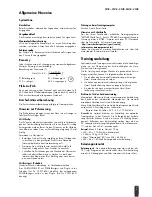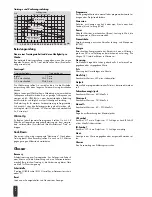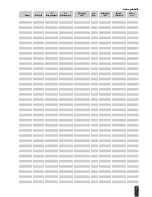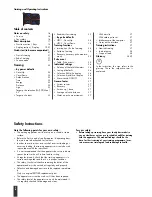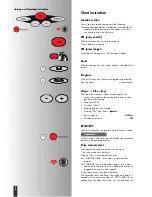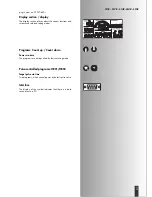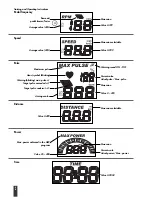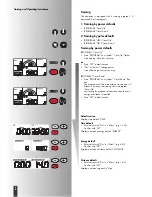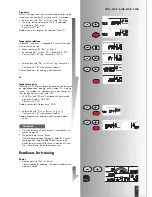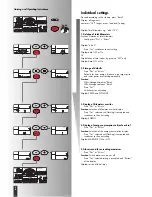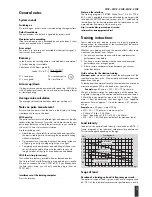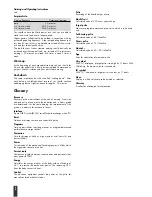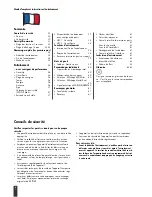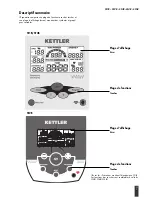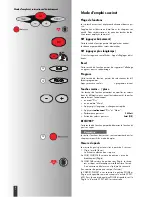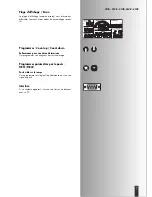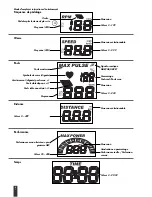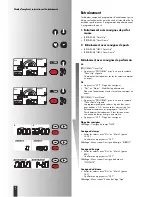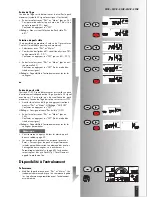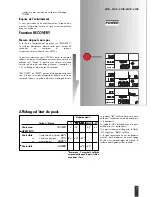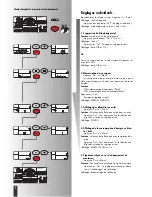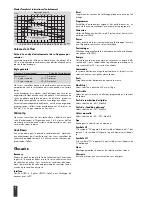
General notes
System sounds
Switching on
On switching on, a short sound is emitted during the segment test.
Default countdown
The achievement of a default is signaled by a short sound.
Maximum pulse exceeding
If the set maximum pulse is exceeded by one pulse beat, 2 short
sounds are emitted every 5 seconds.
Error output
For errors, e.g. recovery not executable without pulse signal, 3
short sounds are emitted.
Recovery
In the function the centrifugal mass is slowed down automatical-
ly. Further training is unsuitable.
Calculation of the fitness grade (F):
Grade (F) = 6.0 –
(
10 x (P1–P2)
)
2
P1
P1 = load pulse,
P2 = recovery pulse
F1 = very good,
F6 = insufficient
Arrows up/down
If a power rate cannot be achieved with speed (e.g. 400 Watts
with 50 pedal revolutions), the up or down arrow prompts faster
or slower pedaling.
Average value calculation
The average value calculation takes place per training unit.
Notes on pulse measurement
Pulse calculation starts, when the heart in the display is blinking
simultaneously to your pulse beat.
With ear clip
The pulse sensor works with infrared light and measures the alte-
rations of the translucency of your skin, which are caused by your
pulse beat. Before you clamp the pulse sensor to your earlobe,
rub it well 10 times to increase circulation.
Avoid disturbing pulses.
• Attach the ear clip carefully to your earlobe and search for
the most suitable point for measuring (heart symbol blinking
without interruption).
• Do not execute your training directly under strong incidence
of light e.g. neon light, halogen light, spot, sun light.
• Completely exclude vibrations and wobbling of the ear sen-
sor including the cable. Always fix the cable to your clo-
thing by means of the clip or even better to a headband.
With chest strap (accessory)
Not included in delivery, available from authorised dealers.
The Cardio-Pulse-Set with Polar chest strap and plug-in is availa-
ble as an accessory (item no. 07937-600). If you already have
the Polar chest strap, you will only need the plug-in (item no.
07937-650).
Interferences at the training computer
Press the reset key
G
Notes on the interface
The training programs “KETTLER World Tours“, Art.-Nr. 7926-
800, which is available at your specialist dealer, makes possible
to control this KETTLER device by means of a PC /notebook via
the interface. For further information and for information on soft-
ware updates (firmware) of this device, go to
http://www.kettler-sport.net/sport/service/
software-fuer-trainingsgeraete.html.
Training instructions
Sports medicine and training science use bicycle ergometry,
among others, for examination of the functionality of the cardio-
vascular and respiratory system.
Whether your training achieved the desired effects after some
weeks you can determine as follows:
1. You achieve a certain stamina with lower cardiovascular
performance than before
2. You keep a certain stamina with the same cardiovascular
performance over a longer period.
3. After a certain cardiovascular performance you recover
faster than before.
Guide values for the stamina training
Maximum pulse:
maximum load means the achievement of the
individual maximum pulse. The maximally achievable heart rate
depends on the age.
To that applies the empirical formula: the maximum heart rate per
minute corresponds 220 pulse beats minus years of age.
Example:
age 50 years > 220 – 50 = 170 pulse/min.
Weight: a further criterion for determination of the optimal trai-
ning data is the weight. The nominal default for maximum load is
3 Watts/kg body weight for men and 2.5 for women. Further-
more, it must be observed, that from age 30 on capability
decreases: for men approx. 1 % and for women 0.8 % per year
of age.
Example:
man; 50 years; weight 75 kg
> 220 – 50 = 170 pulse/min. maximum pulse
> 3 Watts x 75 kg = 225 Watts
> Minus “age discount” (20 % of 225 = 45 Watts)
> 225 – 45 = 180 Watt (nominal default for maximum load)
Load intensity
Load pulse: the optimal load intensity is achieved at 65–75 %
(comp. diagram) of the individual cardiovascular performance.
This value changes depending on the age.
Scope of load
Duration of a training unit and its frequency per week:
The optimum scope of load is given, when over a longer period
65–75 % of the individual cardiovascular performance is achie-
Pulsediagramm
Fitness and Fat Burner
220
200
180
160
140
120
100
80
Pulse
Age
20 25 30 35 40 45 50 55 60 65 70 75 80
Maximalpulse
(220 minus Age)
Fitnesspulse
(75% of Max.Pulse)
Fat combustion pulse
(65% of Max.Pulse)
90
27
GB
SF1B – SF2B – SF3B –SF4B – SF5B
Summary of Contents for SF1B
Page 143: ...143 RUS SF1B SF2B SF3B SF4B SF5B SF1B SFB SF2B SF4B SF5B SF2B SF1B SF3B...
Page 145: ...POLAR Plug In 07937 600 POLAR Plug In 07937 650 HRC1 HRC2 145 RUS SF1B SF2B SF3B SF4B SF5B...
Page 146: ...146 RUS G 11 0 499 HRC HRC Programm 25 400 0 220 0 99 9 0 199 AVG AVG 0 99 59 1 11...
Page 147: ...3 0 25 Power 5 5 4 POWER 147 RUS SF1B SF2B SF3B SF4B SF5B 0 9999...
Page 155: ...155 RUS P1 P2 O...
Page 156: ...HEINZ KETTLER GmbH Co KG Postfach 1020 D 59463 Ense Parsit www kettler net docu 1445j 09 14...

